
Volume 7 - Spring 1999
Workshop Gadgets and other Innovations
by Arthur W. Johnson
Many binding workshops boast tools and equipment that have been fashioned by craftspersons as aids to their working proficiency. Often unique, only one is made, they are personal to the innovator. Some of these gadgets have been devised out of necessity in order to meet a problem but all have the common factors of ingenuity and economy. It is unfortunate that these ideas are not always communicated to other binders. Should others wish to share their inventiveness, the editor will be pleased to receive drawings and explanations. These will be published in a future newsletter as an addition to the following.
The bookbinder may be familiar with a bone folder used exclusively for box making. Instead of the usual spear shape the ends are angled to 600 in order to manipulate the covering materials into corners and inner edges.
The blade of a hand hacksaw is of high-grade steel and can be ground and shaped into an excellent trimming-out knife. Similarly the engineer's heavier blade, which is 30mm wide, will produce a first class paring knife. The teeth are filed away and the shaft bound with leather.
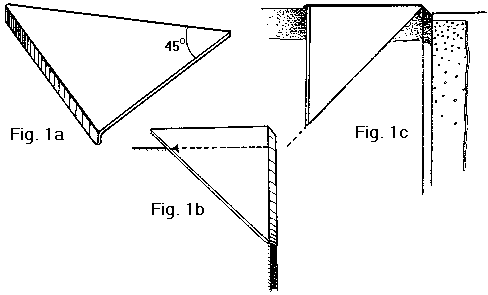 Round
files are preferable to a coarse handsaw for cutting into paper and boards.
They may be adopted for making channels in the backs of sections for sunk cord
work and for the slots which contain the cords when the boards are laced on.
A file, with the trade name 'Abra' is manufactured from a special metal that
enables it to be bent by hand to the curve of a spine. These are obtainable
in sizes from 1 - 5mm in diameter.
Round
files are preferable to a coarse handsaw for cutting into paper and boards.
They may be adopted for making channels in the backs of sections for sunk cord
work and for the slots which contain the cords when the boards are laced on.
A file, with the trade name 'Abra' is manufactured from a special metal that
enables it to be bent by hand to the curve of a spine. These are obtainable
in sizes from 1 - 5mm in diameter.
The clips or 'pliers' used by market-stall holders to display goods or retain covers will do service as band nippers. Some may have handles and grips covered with plastic, others are plain and can be faced with leather. Provided the spring is not too powerful they will not bruise the leather when nipping the bands. They are cheap and easily available.
A simple measuring gauge for corners is cut from a thin piece of aluminium shaped as figure 1a. It can be used to measure, place or trim out leather and cloth corners. The required size is marked on the hypotenuse of the triangle, figure 1b. A guideline of 450 can be drawn when mitering corners and putting down a leather joint, as in figure 1c.
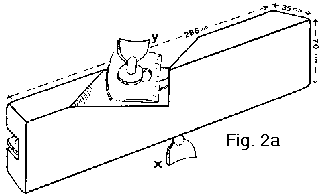
Books requiring thick boards generally have these bevelled for appearance and this dusty and laborious task is made easier by the gadget illustrated in figures 2a & b. Thinner boards may also be shaped but all bevelling is done before the boards are attached to the book.
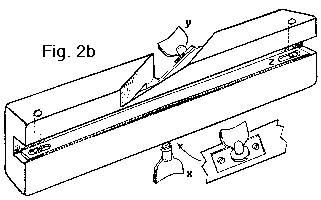 The
materials required for assembly are a piece of hardwood, two wing bolts, a strip
of aluminium, two threaded metal plates, two washers, two small screws and a
spokeshave blade. The thickness of the board to be bevelled is set by wing bolt
X whilst the other adjusts the angle of the bevel Y. The plugged holes are for
access to the screws retaining the slotted aluminium strip Z.
The
materials required for assembly are a piece of hardwood, two wing bolts, a strip
of aluminium, two threaded metal plates, two washers, two small screws and a
spokeshave blade. The thickness of the board to be bevelled is set by wing bolt
X whilst the other adjusts the angle of the bevel Y. The plugged holes are for
access to the screws retaining the slotted aluminium strip Z. 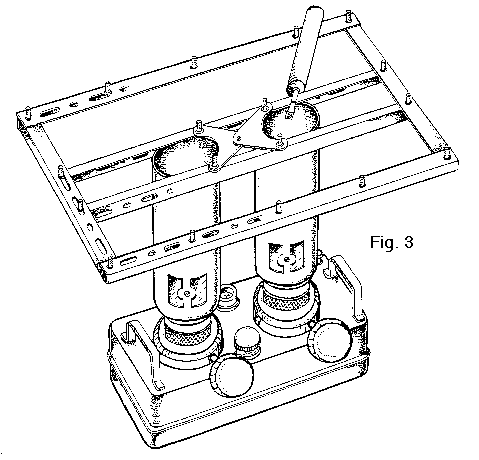
An electric finishing stove
is expensive to buy and its running cost is high as energy is wasted as the
stove is heated. As only a small section of each tool is in contact with the
hotplate, it takes time to reach the temperature required for gold and blind
finishing. A portable paraffin stove is an acceptable option. A new or second
hand domestic stove, preferably with a double burner, is obtained and the outer
casing discarded. A framework of lightweight Dexion, or similar drilled and
slotted angle iron, is constructed to fit firmly on the two chimneys. The pieces
are secured with nuts and long bolts, and these also serve to prevent the finishing
tools from rolling out of position. The faces of the tools rest within the chimney
rims whilst the handles are protected by the frame. If the wicks are trimmed
evenly and the surfaces cleaned the resulting blue flame will heat the tools
in seconds. The stove is safe, odourless, free from soot and very economical
with fuel. The stove in figure 3 has been in constant use for decades.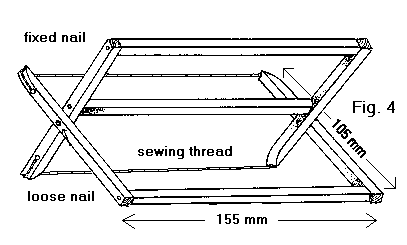
An innovative device for laying gold leaf onto the concave foredge of a book is illustrated in figure 4. The gadget described was purchased privately in Europe but to the best of knowledge does not appear in suppliers' catalogues. However caution must be observed if making a similar model as it may be protected by a patent. The construction is simply made from 7mm square pieces of hardwood. Balsa is too soft. The usual procedure when gilding a foredge is to tilt the press, apply glaire to cover a little more then half the width of the foredge and lay the gold leaf by means of a paper strip or gilder' s tip. The press is then tilted the other way and the remainder of the edge completed in the same manner. The gilding frame is used as follows but the press is not tilted. Gold leaf is cut on the pad in separate pieces, each a little wider than the curved edge and sufficient to cover the foredge. If the book is large, half the length may be done at a time. Glaire is washed on but not to excess as to cause the liquid to funnel down the curve. The two threads are lightly Vaselined and by placing the middle fingers between the top bars the distance between the threads can be adjusted and held with the thumb and little finger. The greased thread is touched to the extreme edges of a piece of gold and lifted free. The leaf will hang in a concave shape that can be manipulated to imitate a similar curve to that of the foredge. Lower the gold onto the glaired surface. The method works very satisfactorily although a steady hand is needed. If by misjudgement cracks appear they are covered by gold applied by means of the gilder's tip.
Arthur W. Johnson, A.T.D., N.D.D. was born in 1920. As well as holding an Art Teacher’s Diploma and a National Diploma in Design he is also an Honary Fellow of both the Institute of Craft Education and Designer Bookbinders.
Arthur has held teaching posts at Hornsey College of Art, Hammersmith School of Art, Willesden College of Art and the London College of Printing. He retired from teaching several years ago. He has also lectured extensively in England, Canada and New Zealand. His work has included Calligraphy, Fine Binding and Antiquarian Book Restoration and his bindings can be found in many public and private collections, including the British Museum.
His excellent book, the Manual of Bookbinding by Thames & Hudson is considered as one of the foremost reference works for bookbinders and is recommended as essential reading by many teachers of bookbinding. He has written two other books which were also published by Thames & Hudson, A Practical Guide to Bookbinding and Book Repair and Conservation and Lettering on Books, published by Puiri Press, New Zealand.
We look forward to publishing further articles by Arthur, in future editions of Skin Deep.
